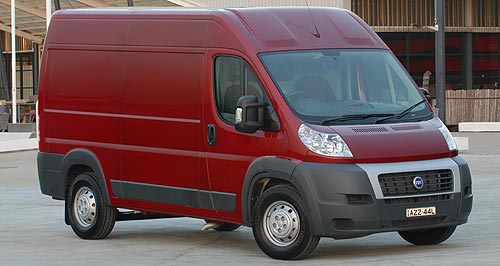News - General News - EmissionsEU sets new CO2 targets for light commercialsRenault Trafic: Light commercials such as the Trafic have new Euro emissions regulations to comply with. Europe gives the green light to a mandatory CO2 target of 130g/km for LCVs by 201717 Feb 2011 By TERRY MARTIN THE European parliament this week voted to adopt a 175g/km carbon dioxide emissions target by 2017 for light commercial vehicles up to 3.5 tonnes gross vehicle mass. The target has a phase-in period starting from 2014, with 70 per cent, 75 per cent and 80 per cent of each manufacturer’s fleet complying in 2014-16 respectively, and 100 per cent from 2017 onwards. Manufacturers registering fewer than 22,000 new vehicles a year can apply for an exemption. A long-term target of 147g/km has also been set, although this is subject to review in 2013. The commercial vehicle target is less stringent than the 130g/km limit being phased in for passenger cars in Europe by 2012, but mirrors the EU car regulations in handing each manufacturer its own overall European fleet average CO2 target, which is based on the weight of each new vehicle it registers in the EU in a given year. Still to be endorsed by the EU Council of Ministers, the new legislation also includes incentives for manufacturers to build highly efficient vehicles, while penalties are in place for those who miss the targets. In Australia, light commercials are included with passenger cars in National Average Carbon Emission (NACE) figures – simply, the average grams of CO2 per kilometre for all new cars, SUVs, utes and vans – for which there are currently no penalties for non-compliance. The federal government is expected to release a new 2015 NACE target in the coming months, which will almost certainly fall below 200g/km for the first time but will still be well short of European regulations. Prior to last year’s election, prime minister Julia Gillard said that, if re-elected, federal Labor would introduce new mandatory CO2 standards for new cars, starting in 2015. She quoted the benefits of a 190g/km national average by 2015 and a further reduction to 155g/km in 2024, but refused to commit to these targets. From the latest NACE figures, Australian LCVs were at 252.8g/km in 2009, while the total figure for all light vehicles that year was 218.5g/km. The 2010 figures are due out soon. Britain’s EU representative Martin Callanan, who steered the new legislation through the European parliament, said: “This legislation has been a difficult balancing act between setting ambitious but attainable environmental targets for manufacturers. “I am satisfied that this is a good deal for the environment, for van manufacturers, and for van users across the EU.” The UK’s peak motor vehicle industry body, the Society of Motor Manufacturers and Traders (SMMT), also welcomed the decision, which extends the phase-in period by a year over the proposed legislation introduced in October 2009. “Industry is pleased that the European parliament has come to a decision on CO2 emission targets for LCVs as vehicle manufacturers are committed to lowering emissions as part of ongoing introductions of low, lower and ultra-low carbon vehicles,” said SMMT chief executive Paul Everitt. “The UK is well placed to capitalise on low carbon technologies and manufacturers now need government to demonstrate its support for sustained investment in skills, R&D and capital equipment.” As GoAuto has reported, the European parliament passed legislation in December 2008 requiring all new passenger cars to reach 130g/km by 2015, with 65 per cent of all new cars reaching the target by 2012, 75 per cent by 2013 and 80 per cent by 2014. Tough individual targets are set for low-volume (sub-10,000 a year) manufacturers, while niche car-makers (10,000 to 300,000) also have an easier ride. For the remainder, any manufacturer exceeding the target will be heavily fined per additional gram of CO2 emitted, for every car registered across Europe. With the new LCV legislation, vans that emit less than 50g/km will earn car-makers ‘supercredits’ during the phase-in period, by counting as 3.5 vehicles towards the average in 2014-2015, 2.5 in 2016 and 1.5 in 2017. Manufacturers can also be granted a credit if they equip vehicles with innovative technologies. The credit will be based on independently verified data and depends on how many vehicles the technologies are applied to. The credit is limited to a maximum of 7g/km on average for each manufacturer’s fleet. On the flipside, each new van over the agreed limits will be subject to penalties rising to €95 per gram from 2019.  Read more |
Click to shareGeneral News articlesResearch General News Motor industry news |

















Facebook Twitter Instagram